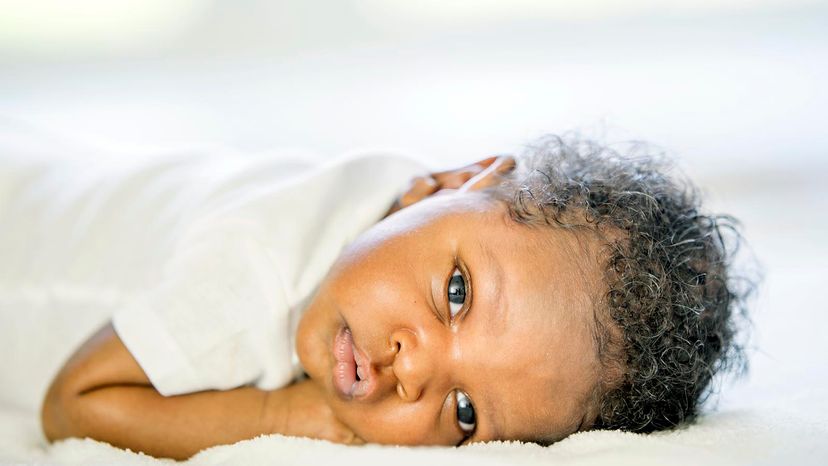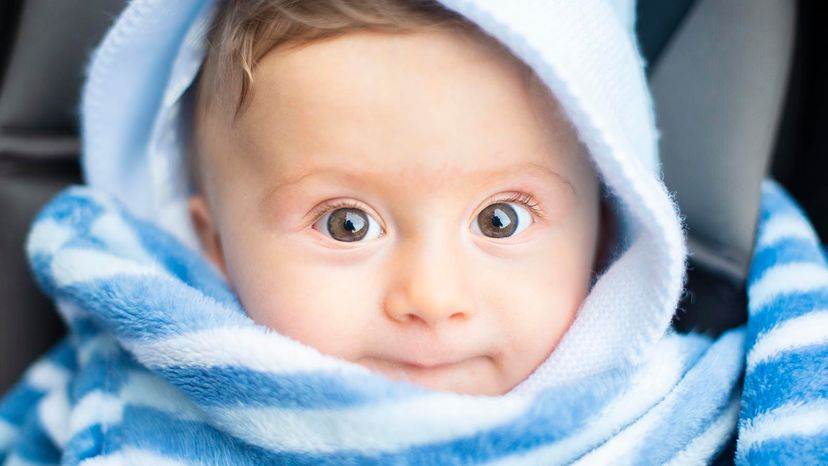 “Almost all newborns have some shade of blue eyes when they’re born. FatCamera/Getty Images
“Almost all newborns have some shade of blue eyes when they’re born. FatCamera/Getty Images
If you’ve ever been around a newborn, you’re likely to gush over chubby fingers and melt into glistening blue eyes that gaze around a post-utero world. Perhaps a year later you see little Johnny again as he smashes his face into the sweet crumbles of his first birthday cake.
Between smears of buttercream frosting, you notice his eyes are brown. This can’t be the same baby — his eyes were blue just a few months ago.
Don’t worry, there’s no cause for alarm. That cake covered brown-eyed baby is the same blue-eyed newborn. Changing eye color is a normal part of baby development. Anywhere from 9 months to 3 years old, a baby’s eye color "sets" on a single hue (or in rare cases two colors called heterochromia) as more melanin is released into their eyes. That’s why when you saw little Johnny’s eyes at his first birthday party, they were no longer blue, they were brown.
Melanin Is What Matters
When you notice someone’s eye color, you’re looking at a part of the eye called the iris, a ring around the pupil filled with melanin. Melanin is a pigment that gives color to our hair, eyes and skin. Depending on the amount of melanin in the iris, it can be shades of gray, green, hazel, amber, brown or even red, and everyone’s eye color is unique.
Eye color isn’t just for aesthetics. Like most of your biology, eye color has a purpose. Thousands of years ago, the first humans had something in common, they all had brown eyes. Just like melanin in skin cells protect against the sun’s damaging UV rays, melanin in our eyes keeps harmful rays from causing long-term damage like cataracts or rare types of eye cancer.
As humans migrated and settled in climates with less harsh sun exposure, they required less melanin and human genetics adapted. Though the most common eye color is still brown across the world, it explains why people with European ancestors tend to have lighter hair, skin and eye colors.
Interestingly, all melanin is brown. The more melanin an eye has, the darker it will appear. In eyes with less melanin — like blue or green — less light is absorbed and it scatters around the eye in a phenomenon called the Tyndall effect. It’s similar to why the sky appears blue.
 “Brown is still the most common eye color across the globe.Manuel Breva Colmeiro/Getty Images
“Brown is still the most common eye color across the globe.Manuel Breva Colmeiro/Getty Images
But Heredity Helps, Too
Heredity of eye color can be straightforward, such as when two parents with a dominant brown-eye gene beget a brown-eyed child. However, a 2016 study showed that 16 genes are involved in determining a person’s eye color.
Two parents with a recessive blue-eye gene can have a child with brown eyes because of modifier genes or mutations. Gene mutations occur when genes are "misspelled" or turned off due to environmental conditions or disease. The point is genetics are complicated, but its why you are the only person in the world with your eyes.
Go ahead and take a longer look in the mirror today. Your eyes tell a unique thousands-year-old story that started with your ancestors and now includes you.
Now That’s Interesting
People who have albinism have very little or no melanin in their skin cells. Their eyes can appear a very light blue, pink or red. This is because without melanin, their irises are clear, so the red we see is the blood vessels inside the eye!














































